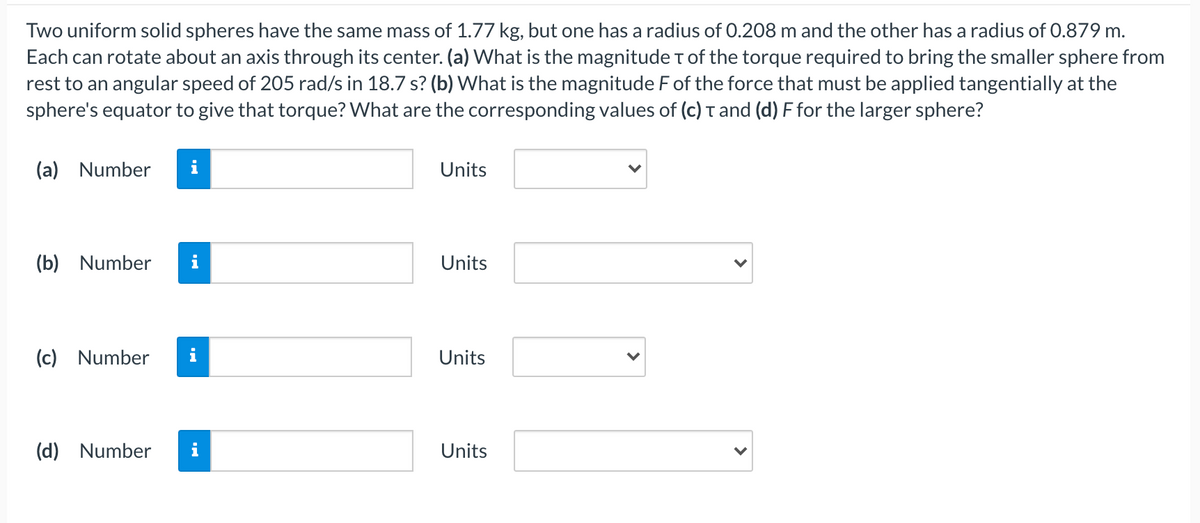Two uniform solid spheres have the same mass of 1.77 kg, but one has a radius of 0.208 m and the other has a radius of 0.879 m. Each can rotate about an axis through its center. (a) What is the magnitude T of the torque required to bring the smaller sphere from rest to an angular speed of 205 rad/s in 18.7 s? (b) What is the magnitude F of the force that must be applied tangentially at the sphere's equator to give that torque? What are the corresponding values of (c) T and (d) F for the larger sphere? (a) Number i Units (b) Number i Units (c) Number i Units (d) Number i Units
Two uniform solid spheres have the same mass of 1.77 kg, but one has a radius of 0.208 m and the other has a radius of 0.879 m. Each can rotate about an axis through its center. (a) What is the magnitude T of the torque required to bring the smaller sphere from rest to an angular speed of 205 rad/s in 18.7 s? (b) What is the magnitude F of the force that must be applied tangentially at the sphere's equator to give that torque? What are the corresponding values of (c) T and (d) F for the larger sphere? (a) Number i Units (b) Number i Units (c) Number i Units (d) Number i Units
Principles of Physics: A Calculus-Based Text
5th Edition
ISBN:9781133104261
Author:Raymond A. Serway, John W. Jewett
Publisher:Raymond A. Serway, John W. Jewett
Chapter10: Rotational Motion
Section: Chapter Questions
Problem 11P: A disk 8.00 cm in radius rotates at a constant rate of 1200 rev/min about its central axis....
Related questions
Question
100%
Please help me with this

Transcribed Image Text:Two uniform solid spheres have the same mass of 1.77 kg, but one has a radius of 0.208 m and the other has a radius of 0.879 m.
Each can rotate about an axis through its center. (a) What is the magnitude t of the torque required to bring the smaller sphere from
rest to an angular speed of 205 rad/s in 18.7 s? (b) What is the magnitude F of the force that must be applied tangentially at the
sphere's equator to give that torque? What are the corresponding values of (c) T and (d) F for the larger sphere?
(a) Number
i
Units
(b) Number
Units
(c) Number
i
Units
(d) Number
Units
Expert Solution
This question has been solved!
Explore an expertly crafted, step-by-step solution for a thorough understanding of key concepts.
Step by step
Solved in 3 steps with 2 images

Knowledge Booster
Learn more about
Need a deep-dive on the concept behind this application? Look no further. Learn more about this topic, physics and related others by exploring similar questions and additional content below.Recommended textbooks for you

Principles of Physics: A Calculus-Based Text
Physics
ISBN:
9781133104261
Author:
Raymond A. Serway, John W. Jewett
Publisher:
Cengage Learning

Physics for Scientists and Engineers: Foundations…
Physics
ISBN:
9781133939146
Author:
Katz, Debora M.
Publisher:
Cengage Learning

University Physics Volume 1
Physics
ISBN:
9781938168277
Author:
William Moebs, Samuel J. Ling, Jeff Sanny
Publisher:
OpenStax - Rice University

Principles of Physics: A Calculus-Based Text
Physics
ISBN:
9781133104261
Author:
Raymond A. Serway, John W. Jewett
Publisher:
Cengage Learning

Physics for Scientists and Engineers: Foundations…
Physics
ISBN:
9781133939146
Author:
Katz, Debora M.
Publisher:
Cengage Learning

University Physics Volume 1
Physics
ISBN:
9781938168277
Author:
William Moebs, Samuel J. Ling, Jeff Sanny
Publisher:
OpenStax - Rice University

Glencoe Physics: Principles and Problems, Student…
Physics
ISBN:
9780078807213
Author:
Paul W. Zitzewitz
Publisher:
Glencoe/McGraw-Hill

Physics for Scientists and Engineers with Modern …
Physics
ISBN:
9781337553292
Author:
Raymond A. Serway, John W. Jewett
Publisher:
Cengage Learning

Physics for Scientists and Engineers
Physics
ISBN:
9781337553278
Author:
Raymond A. Serway, John W. Jewett
Publisher:
Cengage Learning